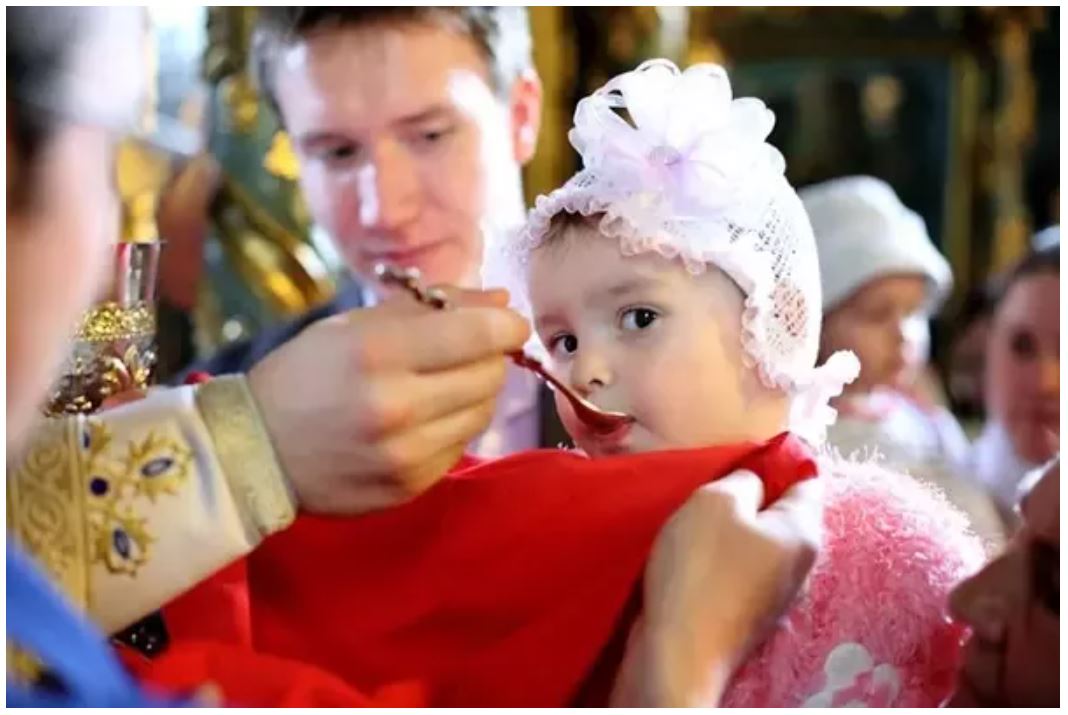As a company that specializes in 14k gold crosses and jewelry, Triantos Crosses understands the importance of tradition and symbolism in the Christian faith. One of the most meaningful traditions that takes place after a baptism is the act of the Godparent bringing the newly baptized child to their first three communions. The first communion is taken on the day of the baptism, and the following two on the Sundays at Divine Liturgy.
What church to attend for communion?
The Godparent is responsible for bringing the child up for communion and should take the child when available. If the Godparent and child are members of the same church, it becomes a beautiful tradition for the child to walk up to the altar with their Godparent. However, if the child and Godparent are members of different churches, the Godparent can make sure to take the child on the occasions they do see each other at the same church. It is important to note that if the Godparent or Godchild is not available for the second or third Sunday, the parent should bring the child up for communion.
What is the significance of the three communions after a baptism?
The specific reason behind the practice of bringing a recently baptized child to receive Holy Communion for three consecutive weeks in the Greek Orthodox Church is not explicitly stated in the religious texts or official doctrines. Instead, it is primarily a tradition that has developed over time within the Greek Orthodox community. However, we can offer some insights into the possible underlying reasons:
- Symbolism of the number three: The number three holds significant symbolism in Christianity, representing the Holy Trinity (Father, Son, and Holy Spirit). By bringing the child to receive Communion for three consecutive weeks, it may be seen as a reflection of this symbolism and a way to emphasize the connection between the child, God, and the Church.
- Spiritual nourishment: Greek Orthodox Christians believe that the sacrament of Holy Communion is a vital source of spiritual nourishment and an essential part of their faith. By bringing the newly baptized child to receive Communion, they believe the child is receiving the Body and Blood of Christ, which strengthens their connection to God and the Church. The first communion is a way to celebrate the child's initiation into the Christian faith and their new life in Christ.
- Integration into the Church: Serving as a way to welcome the child into the community of believers and establish a spiritual foundation from the early stages of their life. The three-week Churching tradition may also serve as a way for the community to support and celebrate the newly baptized child and their family. It allows the family to receive continued blessings, prayers, and guidance from the church community during the initial stages of the child's spiritual journey.
- Completion of the baptismal journey: The three weeks of Churching symbolize the completion of the baptismal journey and the child's full initiation into the life of the Church. Baptism is seen as the first sacrament, followed by Holy Communion, which is seen as the next step in the child's spiritual journey. They serve as a way for the child to connect with the community of faith. By participating in these communions with other members of the congregation, the child can feel a sense of belonging and connection with the church.
What side to hold the baby to the altar?
It is also important to note that the Godparent should carry the child on the right side of their body as they approach the altar. If there are two Godparents, one should carry the baby to the altar and the other should hold the lit candle. At the time of communion, the Godparent should provide the priest with the baptismal name of the baby right before the baby accepts communion.
What do I do with the candle?
Another important aspect of these first three communions is the use of the baptismal candle. The Godparent should bring the baptismal candle to the church each of these three communions and light it using the flame from a lit candle in the narthex. The lit candle should be brought up to the altar during communion and can be blown out at any point after communion.
It's worth mentioning that the schedule of these three communions may vary depending on the church, so it's always important to check with the church or the priest in charge to confirm the schedule. Triantos Crosses is proud to offer a wide range of 14k gold crosses that can serve as a meaningful and special keepsake for these important moments in a child's life. Whether worn as a necklace or displayed at home, a 14k gold cross is a beautiful symbol of faith and tradition.
It's important to note that specific practices and customs can vary within the Greek Orthodox Church, and the three-week Churching tradition may not be uniformly followed in every parish. Different local traditions and cultural factors can influence the customs observed.
Let us know in the comments below what are the traditions in your Parish.


5 comments
Supper liked this article. Very interesting!
Great read. nice to know traditions are being kept up and that our faith stays strong!
Very good read. it’s nice to see traditions kept up with time and why.
Wonderful read, I’ve always wondered why we do this!
It’s wonderful to see the emphasis on tradition, symbolism, and spiritual nourishment within the Christian faith. I recently baptized myself and took my godchild for communion three times after. It was a deeply meaningful experience, and I hope to be able to continue taking them at least once a month for communion to keep their connection with God strong.